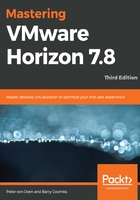
Why do we need to manage user profiles differently in VDI?
In a VDI solution, one of the key benefits is the way the virtual desktop is either built on demand or delivered from a pool of prebuilt, non-persistent desktops and then delivered back to the user. The typical deployment model is the non-persistent model, which basically means that the user doesn't own their own desktop or have personal files, data, or settings stored on it either. It's these settings that form their user profile.
When they log in, they could have any desktop delivered to them from a pool of available virtual desktop machines. This means that the virtual desktop that is delivered would not be personalized to that user. It would just be a standard vanilla build of the operating system and applications.
This is where View Persona Management comes into play and delivers the user's profile to that non-persistent virtual desktop machine they have been assigned to, effectively making it their own.
When we talk about the desktop being built on demand, we are again referring to the composite desktop model and how a desktop is put together from several different components. As a reminder, the desktop can be broken down into three components: the operating system, applications, and the user's personalization or profile, essentially, the bit that makes the desktop yours. As a user logs in, all these pieces come together to deliver the end user desktop experience. With View Persona Management, we are talking about the user's profile.
In this section, we will introduce you to View Persona Management and its benefits for managing user profiles. A deeper dive into the technical details and configuring View Persona Management can be found in Chapter 17, Managing the End User Environment in Horizon.